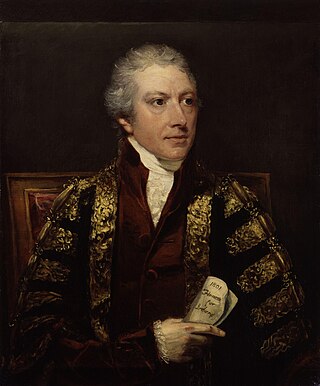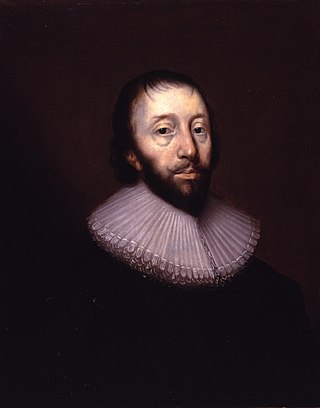Related Research Articles

Sir Anthony St Leger, KG, of Ulcombe and Leeds Castle in Kent, was an English politician and Lord Deputy of Ireland during the Tudor period.

Charles Abbot, 1st Baron Colchester PC, FRS was a British barrister and statesman. He served as Speaker of the House of Commons between 1802 and 1817.

Sir Dudley Digges was an English diplomat and politician who sat in the House of Commons between 1610 and 1629. Digges was also a "Virginia adventurer," an investor who ventured his capital in the Virginia Company of London; his son Edward Digges would go on to be Governor of Virginia. Dudley Digges was responsible for the rebuilding of Chilham Castle, completed in around 1616.
The Chancellor of the Exchequer of Ireland was the head of the Exchequer of Ireland and a member of the Dublin Castle administration under the Lord Lieutenant of Ireland in the Kingdom of Ireland. In early times the office was sometimes called the Chancellor of the Green Wax. In the early centuries, the Chancellor was often a highly educated cleric with knowledge of Finance. In later centuries, when sessions of Parliament had become regular, the Chancellor was invariably an MP in the Irish House of Commons. Walter de Kenley, Chancellor from 1292 until his death, was both a judge of the Court of Common Pleas (Ireland) and a distinguished military commander who gave good service against the Gaelic clans of County Wicklow.
A fiant was a writ issued to the Irish Chancery mandating the issue of letters patent under the Great Seal of Ireland. The name fiant comes from the opening words of the document, Fiant litterae patentes, Latin for "Let letters patent be made". Fiants were typically issued by the chief governor of Ireland, under his privy seal; or sealed by the Secretary of State, who served as "Keeper of the Privy Seal of Ireland", just as the English Secretary of State did in England. Fiants dealt with matters ranging from appointments to high office and important government activities, to grants of pardons to the humblest of the native Irish. Fiants relating to early modern Ireland are an important primary source for the period for historians and genealogists. The Tudor fiants were especially numerous, many relating to surrender and regrant. A fiant often provides more information than the ensuing letters patent recorded on patent rolls. There are also fiants for which the patent roll does not list any letters patent, either because none were issued or because those issued were never enrolled, through accident or abuse. Prior to the Act of Explanation 1665, letters patent were enrolled after they were granted; under the act, the fiant was enrolled first, and the letters issued afterwards. Thereafter the rolls, which were catalogued in the 19th century, give the same information as the original fiants.

Sir Frederick Hamilton was a Scottish soldier who fought for Sweden in the Thirty Years' War in Germany and for the Covenanters in Ireland, Scotland, and northern England. He built Manorhamilton Castle, County Leitrim, Ireland. His son Gustavus became the 1st Viscount Boyne.
Robert Braybrooke (1336/7-1404) was a medieval cleric and King's Secretary. He was Dean of Salisbury and Bishop of London.

Sir Oliver St John, 1st Viscount Grandison was an English soldier and politician who became Lord Deputy of Ireland.

In the Kingdom of England, the title of Secretary of State came into being near the end of the reign of Elizabeth I, the usual title before that having been King's Clerk, King's Secretary, or Principal Secretary.

Francis Annesley, 1st Viscount Valentia, was an English statesman during the colonisation of Ireland in the seventeenth century. He was a Member of Parliament for both the English and Irish houses, was elevated to the Irish peerage as Baron Mountnorris, and later gain the additional title Viscount Valentia. He is best remembered for his clash with the Lord Lieutenant, Thomas Wentworth, who in order to render Annesley powerless had him sentenced to death on a spurious charge of mutiny, although it was clearly understood that the sentence would not be carried out.
Sir William Parsons, 1st Baronet of Bellamont, PC (Ire), was known as a "land-hunter" expropriating land from owners whose titles were deemed defective. He also served as Surveyor General of Ireland and was an undertaker in several plantations. He governed Ireland as joint Lord Justice of Ireland from February 1640 to April 1643 during the Irish rebellion of 1641 and the beginning of the Irish Confederate War.

The Principal Secretary of State, or Principal Secretary of the Council, was a government office in the Kingdom of Ireland. It was abolished in 1801 when Ireland became part of the United Kingdom of Great Britain and Ireland under the Acts of Union 1800.
Sir John Alan was a leading English-born statesman in sixteenth century Ireland. He was a member of the Irish House of Commons, and held the offices of Master of the Rolls in Ireland, Chancellor of the Exchequer of Ireland and Lord Chancellor of Ireland. Though he was childless himself, one of his brothers, William, founded a prominent landowning dynasty in County Kildare. The family's holdings included lands at Celbridge, St. Wolstan's and Kilteel, County Kildare, as well as substantial lands in County Dublin. They also acquired a baronetcy.
Sir Paul Davys was an Irish politician and civil servant, who held office as Clerk to the Privy Council of Ireland and later as Secretary of State (Ireland). He had considerable influence in public affairs, and enjoyed the close friendship of the Lord Lieutenant, James Butler, 1st Duke of Ormonde. His sons, William and John, both attained high office. He was the grandfather of Paul Davys, 1st Viscount Mount Cashell.
Sir Henry Holcroft (1586–1650) was an English politician who sat in the House of Commons between 1624 and 1629 and held appointments in the Dublin Castle administration in Ireland.
John Challoner MP was the first Secretary of State for Ireland, appointed by Queen Elizabeth I of England in 1560. He also sat at different times as a member of parliament in both the Parliament of England and the Parliament of Ireland. He should not be confused with his contemporary, Alderman John Challoner, Mayor of Dublin between 1556 and 1557, who died in 1565.
Walter Cowley was an Irish lawyer and politician who was the first holder of the office of Principal Solicitor for Ireland, which was created for him. He was a client of Thomas Cromwell, and later of John Alan, the Lord Chancellor of Ireland, and this connection ultimately led to his downfall. He is best remembered as an ancestor of the 1st Duke of Wellington.
Sir Henry Colley, or Cowley was an Irish soldier and landowner of the Elizabethan era. He is chiefly remembered today as an ancestor of the 1st Duke of Wellington.
Edmund Henry Pery, 1st Earl of Limerick PC, styled Lord Glentworth between 1794 and 1800, and Viscount Limerick until 1803, was an Irish peer and politician.
The Great Seal of Ireland was the seal used until 1922 by the Dublin Castle administration to authenticate important state documents in Ireland, in the same manner as the Great Seal of the Realm in England. The Great Seal of Ireland was used from at least the 1220s in the Lordship of Ireland and the ensuing Kingdom of Ireland, and remained in use when the island became part of the United Kingdom of Great Britain and Ireland (1801–1922), just as the Great Seal of Scotland remained in use after the Act of Union 1707. After 1922, the single Great Seal of Ireland was superseded by the separate Great Seal of the Irish Free State and Great Seal of Northern Ireland for the respective jurisdictions created by the partition of Ireland.
References
- ↑ Elliss, William Smith (1866). Notices of the Ellises of England, Scotland, and Ireland, from the conquest to the present time. p. 267.
- ↑ Wood, Herbert (1928). "The Offices of Secretary of State for Ireland and Keeper of the Signet or Privy Seal". Proceedings of the Royal Irish Academy: Archaeology, Culture, History, Literature. 38: 63. Retrieved 20 August 2023.
- ↑ Barry, Judy (October 2009). "Holcroft, Henry". Dictionary of Irish Biography. Retrieved 13 February 2023.
- ↑ Mac Cuarta, Brian (2001). "The Plantation of Leitrim, 1620-41". Irish Historical Studies. 32 (127): 305. Retrieved 20 August 2023.